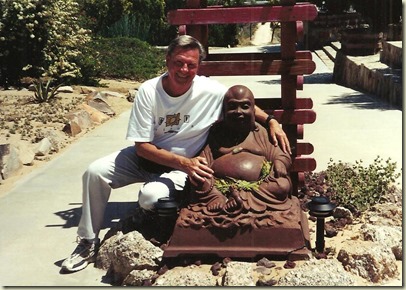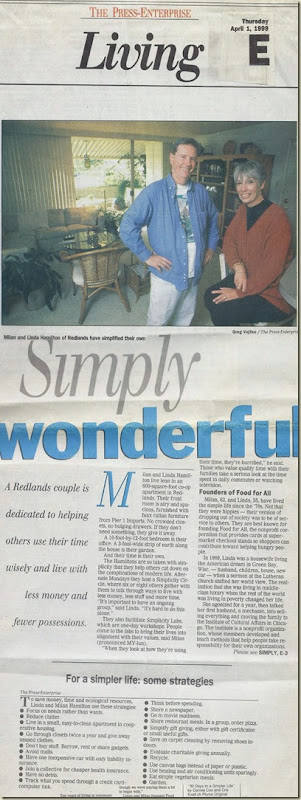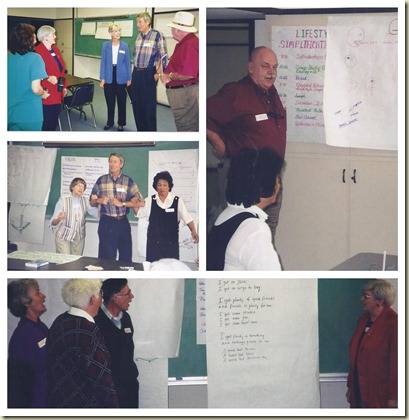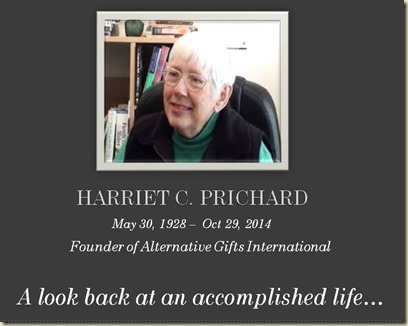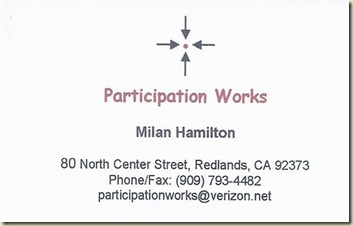Spring 1998. Nearly 14 years of devoting ourselves to birthing, nurturing, selling, directing, facilitating, merging, and finally letting go of the phenomenon of FOOD FOR ALL, Inc., we looked at each other and wondered: “What next?”
We were too young (I – 61; Linda – 55) and too poor to retire. Our “severance” pay package had run out and any savings were in a couple of retirement IRAs. But we needed time to process the reality that we no longer had to keep a rigorous and demanding schedule. We suddenly realized that we had not thought through any plans for our future. So we made a pact that we would take two or three months “off” and each explore what might draw us next. Linda took off (literally) and pieced together several meditation retreats – a Women’s Retreat with Ruth Denison at her Joshua Tree center in the desert; a Zen retreat which was happening at the same center; a ten-day retreat on Mindfulness Meditation in Yucca Valley (that one I managed to attend with her); and several individual ones of her own.
I, meanwhile, dabbled in several pursuits, trying to find my creative side: a watercolor class, a computer class on Microsoft Word (I had managed to escape the computer revolution due to having a secretary for all those FOOD FOR ALL years), eight weeks of Spanish (classes all through the Redlands Adult School).
At the beginning of the summer, after spending enough time exploring, the Hamiltons came together for several weeks of “family workshops,” attempting to articulate our family’s values and a vision for where we anticipated life might take us next. We were clear that addressing important issues such as peace and justice, poverty, the environment, would continue to underlie whatever we were doing to sustain ourselves. As for our own living situation, we were committed to “living simply, that others might simply live,” a slogan we adopted from the Simplicity Movement which was gaining momentum during the 90s. Later we would even offer to conduct a series of one-day workshops, called Lifestyle Simplification Labs, which we adapted from what some of our colleagues, Nelson and Elaine Stover, had created on the east coast.
Our First Lifestyle Simplification Lab
One of the benefits of our years working with struggling nonprofit agencies was we had learned the value of networking. As part of our “right livelihood” career exploration we talked to a lot of people we had met through our work. It might come as no surprise that not many of them were in the food industry. There were times when I would get these strange feelings in the pit of my stomach whenever we had to shop in a supermarket (I have since got over that reaction). The people we approached for guidance and advice were those who were working on the front lines, the nonprofit service agencies. At the same time we began kicking around what it would be like to take our experience with both the Institute of Cultural Affairs and FOOD FOR ALL, and form our own little company to help struggling nonprofit organizations (we had lots of experience there).
At the beginning of the summer we were approached by Harriet Pritchard, who founded Alternative Gifts International, a nonprofit which conducted Holiday Gift Fairs, mostly in churches. Harriet was nearing retirement age and saw us as potential “successors” to carry on after her and grow the organization. Milan took the job of Director of Marketing, commuting to Lucerne Valley, a little town in the high desert, once a week, staying in a make-shift apartment in one of Harriet’s buildings. The organization, it turned out, was not quite ready or us, and we for it. So after one season of Holiday gift fairs, Harriet and I mutually agreed to sever the relationship. I just learned from the current executive of AGI that Harriet died in November 2014. I include the internet address of AGI below in case you are interested in reading about another “social pioneer” and a unique nonprofit that is still in service with which I had a brief connection.
https://www.alternativegifts.org/
Meanwhile Linda had made the acquaintance of Linda Dunn, Director of Inland Agency, which worked with local communities throughout Riverside and San Bernardino counties. IA had just received a grant to work with two small communities, Adelanto and Nuevo. Linda was hired for one year to direct these two projects. The projects were aimed at building local community capacity. After bringing together a wide diversity of people, young and old, holding visioning workshops, identifying local leaders, forming local steering groups, it became clear that the Nuevo community was not right for the project. But Adelanto really came together and began to make great strides. Linda was commuting to the high desert several days a week. Adelanto was a city with great needs, lots of boarded up houses, left after the real estate bust of the 90s, an absence of a supermarket and adequate local services. But the methods Linda was applying were paying off and people began to invest in their own future. An innovative Neighborhood Academy was facilitated by our ICA colleague Raul Jorquera of Phoenix. And a dramatic rehearsal of residents’ aspirations was enacted with the help of another east coast colleague, Bill Grow, founder of Swamp Gravy. Adelanto became a model of what a local community can do when community members get committed and get some tools to realize their vision.
I mentioned earlier that we had the idea to form our own company. Actually, while working with Alternative Gifts International and Inland Agency we wrote a business plan and completed a strategic plan for Participation Works, which we would see grow into a viable self-support vehicle, finally retired from active service just last year. We were not sure exactly what our niche would be. We sent letters to city and county agencies, school districts, and nonprofit executives. We talked to our friends. We offered to do a few “freebies.” We kept busy making contacts but felt like it was going to take a couple years of treading water before we actually had any actual clients.
Then right in the middle of Linda’s Adelanto contract, we submitted a proposal to the County of San Bernardino, which was attempting to integrate all of their Human Service agencies to provide more seamless services to clients. We knew the project, which was to be a year or more to completion, was more than we could handle, so we brought in one of our ToP Trainer colleagues (ToP = Technology of Participation), Jane Stallman, from northern California. Jane had had experience working with large and complex organizations. We were competing with a couple of other consulting firms from outside California. And surprise! We got the contract. The next six to eight months were filled with meetings, meetings, meetings. The County gave us office space in one of their buildings. Jane was commuting from Oakland, spending three days a week with us, rooming at my mother’s place. I was assigned the duty of handling all the contract obligations, invoicing and depositing and writing checks, as well as documenting all of the meetings and planning sessions (my new found skill with Microsoft Word). Weekly meetings with the twelve-plus members of the Leadership Team, comprised of the heads of all the various human service agencies. Monthly meetings, sometimes more often, with the management staff from all these agencies. Endless hours meeting among ourselves to stay ahead of the whole process. The process was kicked off with a two-day complete strategic planning retreat, followed by involving around 200 management and line staff members. In addition to all of these meetings, our team was tasked to provide training in the methods we were using (ICA ToP methods) for the County Training Department staff.
To complicate life further, most of the individual members of the Leadership Team, all agency heads who were used to running their own show, managing their own budgets, and maintaining their own little fiefdoms, were resisting the process of bringing them all together into one coordinated system. But they were instructed by the County Administrator and the Head of Human Services, to make this work. That is until, John Michaelson, who hired us, had two heart attacks within a space of a few weeks. He never was able to return to work and retired before the end of the summer. Our champion was gone. We still had the better part of a year to go on our contract. About the middle of August we received a letter from John’s deputy director: “In view of recent developments, we have decided to go in a different direction. Your services will no longer be needed. Thank you for your service.” I called the County finance office to find out about our contract fulfillment. I submitted an invoice for the balance of our contract and received a check for the full amount. You may wonder what ever happened to the County of San Bernardino Human Services Department. It still functions. In its separate fiefdoms. But, a part of the later story is that the Training Department people we trained in participatory methods, have continued to use those methods in helping County departments in their planning, and PERC, as it is known, has continued to send people every year for training in the courses that we have offered. We still encounter people, from time to time, who participated in the process and/or the trainings, and they speak enthusiastically about recalling what was accomplished.
It is difficult to believe that all of this could have happened in the first two years after we left the leadership of FOOD FOR ALL. But it seems to have been the launching pad for our little home-based company. Participation Works was on the way! And we are barely at the end of the twentieth century.
